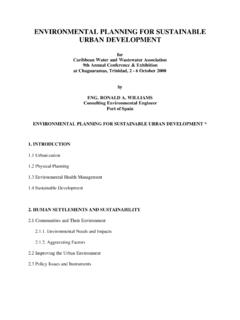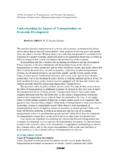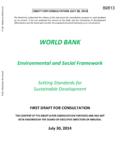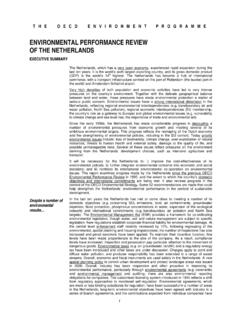Transcription of Environmental proposed investment or development …
1 1 | P a g e Environmental Impact Assessment Introduction The main focus of this Guidance Note is the use of EIA as a policy tool available to policy makers for effective pollution EIA facilitates pollution management through its link to Environmental standards by identifying if the This guidance note was prepared by Helena Naber ( Environmental Economist, ENV), with significant contribution from Ernesto S nchez-Triana (Lead Environmental Specialist, SASDI) and Santiago Enriquez (Consultant, SASDI), and contribution from Francisco Giner de Los Rios (Consultant). Peer reviewers included Harvey Himberg (Consultant, OCPQC) and Hocine Chalal (Regional Safeguards Adviser, MNACS). Additional comments and contributions were received from Maged Hamed (Senior Environmental Specialist, MNSSD), as well as Carmen Bernardo-Garcia (Junior Professional Officer, SASDI), Giovanni Bo (Consultant, LEGEN); Nicole Maywah (Consultant, SASDI); Olga Puntus (Consultant, CESAD), Rafael Hernandez (Consultant, ENV), Raffaella Marinucci (Consultant, CESI), and Zhengfang Shi ( Environmental Specialist, CES-IFC).
2 Editorial assistance was provided by Stan Wanat (Consultant), Juliette Guantai (Program Assistant) and James Cantrell (Communication Analyst). The task team leaders for this product are Kulsum Ahmed (Lead Environment Specialist, ENV) and Helena Naber ( Environmental Economist, ENV). The product was prepared under the guidance of the following World Bank Group management: James Warren Evans / Mary Barton-Dock (Directors, Environment Department, World Bank), Bilal Rahill (Senior Manager, IFC), and Frank Lysy / Ravi Vish (Director, MIGA). 1 Environmental Assessment (EA) is a main tool for the World Bank to ensure Environmental and social sustainability. This Guidance Note however does not address the use of EA by the World Bank but rather discusses EA as a tool that may be used by government stakeholders for effective pollution management. For guidance on the World Bank s Environmental assessment policy, please refer to Safeguard Policies on the World Bank site: and to IFC performance standards: proposed investment or development project satisfies applicable Environmental standards or needs, and mitigating impacts to comply with standards.
3 Furthermore, EIA enhances public participation and engages stakeholders to inform decision makers of different views. Additionally, EIA, in conjunction with monitoring tools and recourse mechanisms, allows the gathering of information on Environmental quality and provides a venue for expression and discussion of diverging opinions. This Guidance Note does not discuss the technical aspects of preparing an Environmental assessment, since numerous resources and good practices are available on preparing an EIA. Instead, this Note focuses on the broader use of EIA as a policy instrument within the range of policy instruments discussed in this toolkit, and which are available to different stakeholders for pollution management. Description and Application of Environmental Impact Assessment The Environmental assessment process would usually, according to the various international approaches currently implemented, incorporate the following main stages: screening to determine applicability and level of detail of an EIA; scoping during which issues that should be taken into consideration are identified and the terms of reference for the EIA are completed; preparation of the Environmental assessment report, including identification of impacts, evaluation of alternatives, and design of mitigation measures; and the preparation of the Environmental management plan, 2 | P a g e which is usually part of the Environmental assessment report, but can be a stand-alone piece for simple projects.
4 Public participation and disclosure are important attributes of the EIA process in many countries. The United States was the first country in the world to introduce Environmental assessment as part of the National Environmental Policy Act (NEPA) in 1969 as a tool that would lead to implementation of NEPA policies. The Environmental assessment process had two major purposes: ensure that decision makers are making informed choices regarding impacts on the environment and open the process to citizen involvement (CEQ 2007). Over the past 40 years, EIA entered the fabric of Environmental governance in over 100 countries worldwide (Glasson and others 2005). EIA also became an important instrument for Environmental sustainability for multi-lateral development agencies, including the World Bank. The Bank introduced EIA as one of its ten Environmental , social, and legal safeguard policies to identify, avoid, and mitigate the potential negative Environmental impacts associated with Bank lending operations (World Bank 1999).
5 Even though most EIA systems follow the steps of the generic EIA, there are substantive and procedural emphasis differences: Nature of EIA. A country s legal system and its political, administrative, and cultural context play an important role in shaping that country s EIA system, and account for differences in EIA systems among countries. As a result, the use of EIA as a tool varies among countries from its consideration as an administrative process that helps incorporate Environmental and social concerns of different stakeholders into the decision-making of authorities. Underlying the value of EIA is the view that Environmental decision-making processes are strengthened when the responsible authority can systematically incorporate the views and opinions of all relevant stakeholders regarding the decision at hand as is the case in the (CEQ 2007). An alternative vision of EIA considers this instrument as an Environmental management tool that helps control the Environmental impacts of a broad range of projects, such as in Brazil where authorities often establish design and operational conditions through the EIA process (World Bank 2008), or Guatemala (World Bank 2006c) and Nepal (World Bank 2007b), where EIA became the main policy instrument to minimize or mitigate Environmental impacts.
6 Such alternative conditions have generated various models of EIA, such as those proposed by Doberstein (2004) who distills two models of EIA: a technical model and a planning model , as two extremes of a continuum with systems of most countries exhibiting a mixture of these. He further notes that most developing countries start with a form of EIA that most closely matches the technical model characterized by a focus on the project level, with weak public participation and reliance on quantitative measurement rather than qualitative perceptions. Screening. Prescriptive and standardized approaches are two general methods for screening. They are defined through positive or negative lists in legislation and regulations, and discretionary or customized approaches where indicative guidance is relied upon to determine requirement for EIA on an 3 | P a g e individual or case-by-case basis (UNEP 2002).
7 Figure 1 presents a framework for screening (UNEP 2002). Screening tools include positive lists that identify activities that require EIA; negative lists that identify activities that are excluded from EIA requirement; expert judgments; or a combination of lists and expert judgments. Screening could also include analysis of impacts and risks, such as in the United States, where EIA applies to investment activities that can pose significant negative impacts. Scoping. Identifying the scope of an EIA study is an important aspect of the EIA process, and as with other aspects of EIA, countries differ in how scope is identified. In some instances, EIA scope is determined either through formal (for example, Ecuador and ) or informal (such as in Peru) consultations; or defined by the legal framework without providing opportunities for public input (for example, Colombia). Terms of reference for EIA are then prepared based on results of consultations, legal requirements, or based on generic terms of reference.
8 An important factor in determining the scope of an EIA is drawing the boundary of the impacts of the proposed activity issues that are appropriately addressed through the EIA process, and making sure that issues that remain outside of this boundary are addressed by other instruments such as Strategic Environmental Assessment (SEA), cumulative impact assessment study, and land use planning. Figure 1. A Framework for Screening (UNEP 2002) 4 | P a g e Preparation, Approval, and Supervision. Supervision of the EIA preparation usually falls either on the sectoral agency (for example, Peru, Ecuador, US), or on the Environmental agency (for example, Belize), or is a responsibility shared by sectoral and Environmental agencies (for example, Argentina). The environment agency s role could range from review and provision of comments about the adequacy of the analysis and the impact on the environment, ensuring public participation in the EIA, to the approval of the EIA, including prior approval of the terms of the reference through the screening and scoping stages.
9 Moreover, in many countries, agencies at the local level (provincial / municipal) are responsible for supervising EIA preparation. For example, in Pakistan the federal Environmental protection agency (EPA) has jurisdiction over all EIAs, but often delegates its power to provincial EPAs, resulting in provincial authorities having jurisdiction for the vast majority of EIA cases except for those involving federal land, military projects, and trans-border or trans-provincial impacts (World Bank 2006d). Many agencies establish registers for consultants, or technical specialists, or firms that carry out EIA (for example, Bangladesh and Guatemala) and some seek to issue certifications or provide learning courses for EIA practitioners in attempts to improve EIA quality (World Bank 2006a; 2006c; 2006f). project proponents, together with the consultants often hired by them to prepare EIA, have significant effects on EIAs quality and objectivity.
10 The capacity of EIA practitioners has often been cited as an important factor in the quality of EIAs, alongside resources allocated to EIAs by proponents (Nadeem and Hameed 2008). Public Participation and Public Disclosure. Countries vary widely in the extent to which EIA relies on public participation, ranging from countries where opening the decision-making process to citizen involvement is one of the main purposes of EIA, to countries where public participation and involvement in the EIA process are not required by EIA regulations and rarely practiced. Most countries fall in between, with regulations that require public involvement at various stages of the EIA process (at screening, scoping, EA preparation, and before and after government decisions). A study of the effectiveness of the EIA Directive in the EU (COWI 2009) revealed that two main benefits of the EIA procedure were it ensures that Environmental aspects are taken into consideration in the decision-making process, and EIA ensures transparency in Environmental decision making.
















